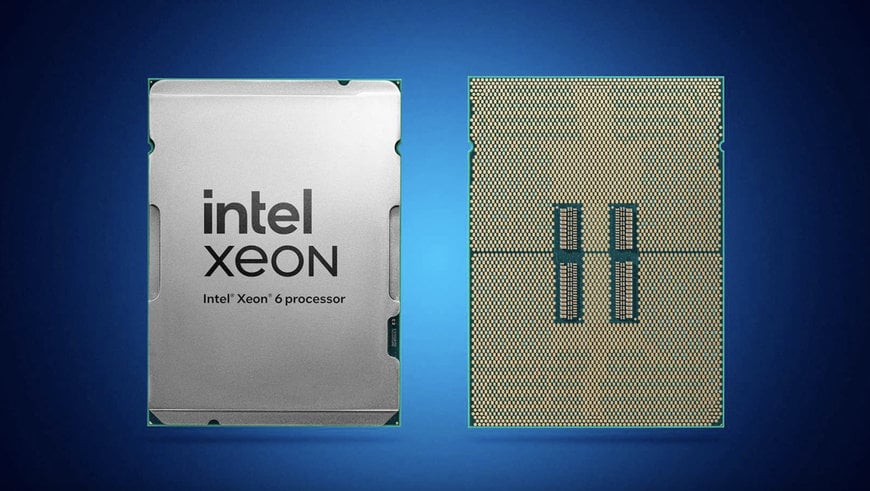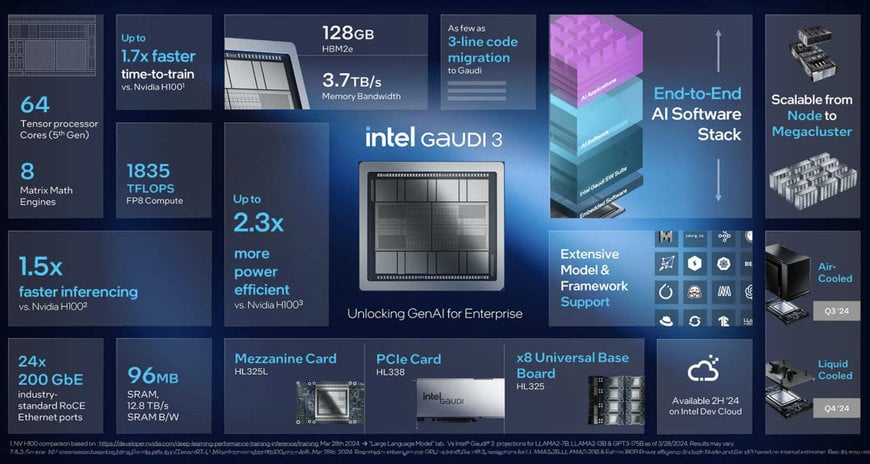electronics-journal.com
05
'24
Written on Modified on
COMPUTEX: INTEL ACCELERATES AI EVERYWHERE, REDEFINES POWER, PERFORMANCE AND AFFORDABILITY
With Intel Xeon 6 processors, Gaudi accelerators and Lunar Lake architecture, Intel delivers the best of AI across cloud, networking, client and edge solutions.
www.intel.com

At Computex, Intel unveiled cutting-edge technologies and architectures poised to dramatically accelerate the AI ecosystem – from the data center, cloud and network to the edge and PC. With more processing power, leading-edge power efficiency and low total cost of ownership (TCO), customers can now capture the complete AI system opportunity.
Intel Enables AI Everywhere
During his Computex keynote, Intel CEO Pat Gelsinger highlighted the benefits of open standards and Intel’s powerful ecosystem helping to accelerate the AI opportunity. He was joined by luminaries and industry-leading companies voicing support, including Acer Chairman and CEO Jason Chen, ASUS Chairman Jonney Shih, Microsoft Chairman and CEO Satya Nadella, and Inventec’s President Jack Tsai, among others.
Gelsinger and others made it clear that Intel is revolutionizing AI innovation and delivering next-generation technologies ahead of schedule. In just six months, the company went from launching 5th Gen Intel® Xeon® processors to introducing the inaugural member of the Xeon 6 family; from previewing Gaudi AI accelerators to offering enterprise customers a cost-effective, high-performance generative AI (GenAI) training and inference system; and from ushering in the AI PC era with Intel® Core™ Ultra processors in more than 8 million devices to unveiling the forthcoming client architecture slated for release later this year.

With these developments, Intel is accelerating execution while pushing the boundaries of innovation and production speed to democratize AI and catalyze industries.
Modernizing the Data Center for AI: Intel Xeon 6 Processors Improve Performance and Power Efficiency for High-Density, Scale-Out Workloads
As digital transformations accelerate, companies face mounting pressures to refresh their aging data center systems to capture cost savings, achieve sustainability goals, maximize physical floor and rack space, and create brand-new digital capabilities across the enterprise.
The entire Xeon 6 platform and family of processors is purpose-built for addressing these challenges with both E-core (Efficient-core) and P-core (Performance-core) SKUs to address the broad array of use cases and workloads, from AI and other high-performance compute needs to scalable cloud-native applications. Both E-cores and P-cores are built on a compatible architecture with a shared software stack and an open ecosystem of hardware and software vendors.
The first of the Xeon 6 processors to debut is the Intel Xeon 6 E-core (code-named Sierra Forest). Xeon 6 P-cores (code-named Granite Rapids) are expected to launch next quarter.

With high core density and exceptional performance per watt, Intel Xeon 6 E-core delivers efficient compute with significantly lower energy costs. The improved performance with increased power efficiency is perfect for the most demanding high-density, scale-out workloads, including cloud-native applications and content delivery networks, network microservices and consumer digital services.
Additionally, Xeon 6 E-core has tremendous density advantages, enabling rack-level consolidation of 3-to-1, providing customers with a rack-level performance gain of up to 4.2x and performance per watt gain of up to 2.6x when compared with 2nd Gen Intel® Xeon® processors on media transcode workloads. Using less power and rack space, Xeon 6 processors free up compute capacity and infrastructure for innovative new AI projects.

Providing High Performance GenAI at Significantly Lower Total Cost with Intel Gaudi AI Accelerators
Today, harnessing the power of generative AI becomes faster and less expensive. As the dominant infrastructure choice, x86 operates at scale in nearly all data center environments, serving as the foundation for integrating the power of AI while ensuring cost-effective interoperability and the tremendous benefits of an open ecosystem of developers and customers.
Intel Xeon processors are the ideal CPU head node for AI workloads and operate in a system with Intel Gaudi AI accelerators, which are purposely designed for AI workloads. Together, these two offer a powerful solution that seamlessly integrates into existing infrastructure.
As the only MLPerf-benchmarked alternative to Nvidia H100 for training and inference of large language models (LLM), the Gaudi architecture gives customers the GenAI performance they seek with a price-performance advantage that provides choice and fast deployment time at lower total cost of operating.

A standard AI kit including eight Intel Gaudi 2 accelerators with a universal baseboard (UBB) offered to system providers at $65,000 is estimated to be one-third the cost of comparable competitive platforms. A kit including eight Intel Gaudi 3 accelerators with a UBB will list at $125,000, estimated to be two-thirds the cost of comparable competitive platforms.
Intel Gaudi 3 accelerators will deliver significant performance improvements for training and inference tasks on leading GenAI models, helping enterprises unlock the value in their proprietary data. Intel Gaudi 3 in an 8,192-accelerator cluster is projected to offer up to 40% faster time-to-train versus the equivalent size Nvidia H100 GPU cluster and up to 15% faster training throughput for a 64-accelerator cluster versus Nvidia H100 on the Llama2-70B model. In addition, Intel Gaudi 3 is projected to offer an average of up to 2x faster inferencing versus Nvidia H100, running popular LLMs such as Llama-70B and Mistral-7B.

To make these AI systems broadly available, Intel is collaborating with at least 10 top global system providers, including six new providers who announced they’re bringing Intel Gaudi 3 to market. Today’s new collaborators include Asus, Foxconn, Gigabyte, Inventec, Quanta and Wistron, expanding the production offerings from leading system providers Dell, Hewlett Packard Enterprise, Lenovo and Supermicro.
Accelerating On-Device AI for laptop PCs; New Architecture Delivers 3x AI Compute and Incredible Power-Efficiency
Beyond the data center, Intel is scaling its AI footprint at the edge and in the PC. With more than 90,000 edge deployments and 200 million CPUs delivered to the ecosystem, Intel has enabled enterprise choice for decades.
Today the AI PC category is transforming every aspect of the compute experience, and Intel is at the forefront of this category-creating moment. It’s no longer just about faster processing speeds or sleeker designs, but rather creating edge devices that learn and evolve in real time – anticipating user needs, adapting to their preferences, and heralding an entirely new era of productivity, efficiency and creativity.
AI PCs are projected to make up 80% of the PC market by 2028, according to Boston Consulting Group. In response, Intel has moved quickly to create the best hardware and software platform for the AI PC, enabling more than 100 independent software vendors (ISVs), 300 features and support of 500 AI models across its Core Ultra platform.
Quickly building on these unmatched advantages, the company revealed the architectural details of Lunar Lake – the flagship processor for the next generation of AI PCs. With a massive leap in graphics and AI processing power, and a focus on power-efficient compute performance for the thin-and-light segment, Lunar Lake will deliver up to 40% lower SoC power and more than 3 times the AI compute. It’s expected to ship in the third quarter of 2024, in time for the holiday buying season.
Lunar Lake’s all-new architecture will enable:
- New Performance-cores (P-cores) and Efficient-cores (E-cores) deliver significant performance and energy efficiency improvements.
- A fourth-generation Intel neural processing unit (NPU) with up to 48 tera-operations per second (TOPS) of AI performance. This powerful NPU delivers up to 4x AI compute over the previous generation, enabling corresponding improvements in generative AI.
- The all-new Xe2-powered GPU design combines new innovations: second-generation Xe cores with Xe Matrix Extension (XMX) for AI, enhanced ray tracing units, low-power hardware decode for the new VVC video codec technology and support for the latest eDP 1.5 panels. The Xe2 GPU cores improve gaming and graphics performance by 1.5x over the previous generation, while the new XMX arrays enable a second AI accelerator with up to 67 TOPS of performance for extraordinary throughput in AI content creation.
- Advanced low-power island, a novel compute cluster and Intel innovation that handles background and productivity tasks with extreme efficiency, enabling amazing laptop battery life.
As others prepare to enter the AI PC market, Intel is already shipping at scale, delivering more AI PC processors through 2024’s first quarter than all competitors together. Lunar Lake is set to power more than 80 different AI PC designs from 20 original equipment manufacturers (OEMs). Intel expects to deploy more than 40 million Core Ultra processors in the market this year.

